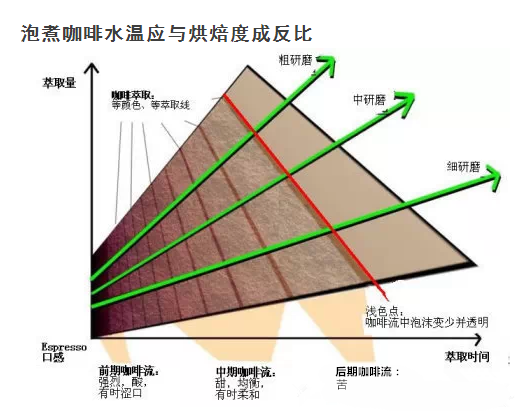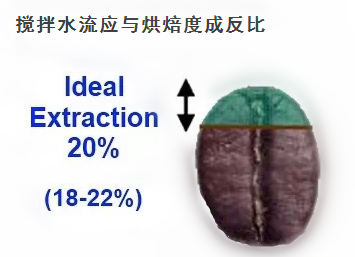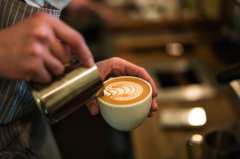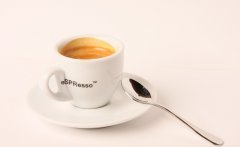Key factors of SCAA Coffee extraction Water temperature, time and Water flow
The three factors affecting brewing coffee are water temperature (Temperature), time (Time) and water flow (Turbulence). The water temperature, the soaking time and the strength of the stirring flow, like the thickness, will affect the extraction rate, and then affect the thickness of the coffee. Interestingly, 3T needs to be inversely proportional to the degree of roasting in order to make delicious coffee.

The water temperature of brewing coffee should be inversely proportional to the degree of baking.
All kinds of brewing method extraction water temperature is not consistent, American electric drip rate kettle due to different brands, mostly controlled in the constant temperature extraction range of 92 ℃-96 ℃, espresso machine can be based on the baking degree used by each store, the water temperature is set in the range of 88 ℃-93 ℃, basically, the deeper the baked, the lower the water temperature is, about 88 ℃, and the shallower the roasting is, the higher the water temperature is, about 93 ℃.
As for hand flushing, siphoning, filter pots and smart filter cups. All manual extraction, it is difficult to achieve constant temperature extraction, water temperature is more elastic, taste spectrum fluctuation is greater than coffee machine, more challenging, this is the reason why players are infatuated with handmade coffee. The water temperature of Japanese hand flushing pot is the most elastic, which varies according to the baking degree and the locking temperature performance of the hand pot, and the extraction temperature is generally between 82 ℃ and 94 ℃. The water temperature of siphon pot extraction is also high and low, about 88 ℃-94 ℃ for high temperature extraction and 86 ℃-92 ℃ for low temperature extraction.
More than 90 ℃, for high temperature extraction, it is easy to increase the extraction rate, increasing alcohol thickness, aroma and scorching bitterness, so it is disadvantageous to deep roasted beans, but it is more suitable for hard beans and shallow roasted coffee, because slightly higher extraction water temperature can upgrade the sharp acid of shallow baked beans to changing active acid, but not too much, the extraction temperature of hand and siphon pot exceeds 94 ℃, it will dissolve more high acid bitterness.
For low temperature extraction below 90 ℃, it will inhibit the extraction rate, reduce aroma and bitter taste, and is more suitable for medium-deep or deep-baked beans, but it should not be too low. Low-temperature extraction by hand should not be less than 82 ℃, so as not to pour out dull coffee. Because low temperature is not conducive to shallow baked beans, only low acid substances that are easy to dissolve can be extracted, but not enough sweet flavor and high sweet and bitter substances can be extracted. as a result, the flavor of shallow roasted coffee brewed at low temperature is not balanced, and there is only one dead acid. Extremely unpalatable, should we use high temperature or low temperature extraction? According to the baking degree of coffee beans, deep roasted beans should be extracted at low temperature, while shallow roasted beans should be extracted at high temperature, that is to say, the baking degree should be opposite to the temperature of boiling water.
The fiber quality of deep-baked beans is seriously damaged, and its structure is loose and fragile, so it is appropriate to be gentle and extracted at a slightly lower water temperature, so as not to extract too many high-coke bitter ingredients; on the contrary, the fiber of shallow baked beans is less damaged and denser, and it is not easy to extract than deep baking. If the shallow roasted coffee is brewed at a water temperature below 82 ℃, it will only extract low acid, unable to extract enough sweetness and a small part of high sweet bitterness and fragrant wood ingredients, resulting in a very uneven and irregular dead sour taste.

The soaking time should be inversely proportional to the baking degree.
At a fixed amount of water, the longer (shorter) the soaking time, the higher (lower) the extraction rate and the higher (lower) the concentration. The baking degree should be taken as the main consideration for the length of soaking time. Shallow baked beans are not easy to extract, so the brewing time should be a little longer than baking. On the contrary, re-baked beans are easier to extract, so the brewing time is slightly shorter than that of shallow baking. In other words, the baking degree should be opposite to the boiling time.
During a visit to Italy, you will find that the extraction time, water temperature, and milliliters per cup of re-roasted coffee in South Italy are obviously less than those slightly lighter in the north, which is the practice of this technique.
The stirring flow should be inversely proportional to the baking degree.
Many people ignore that the strength of the current can also affect the extraction rate of coffee, which in turn affects the concentration. Water flow refers to the force of hot water passing through or impacting coffee granules. The stronger the stirring water is, the more it can promote the extraction of coffee ingredients. If there is no water flow to promote the extraction of follicular coffee, the coffee particles are tangled together, which is easy to cause uneven extraction, resulting in an extraction rate of less than 18% of the lower limit, and the coffee flavor is too weak. However, if the current is too strong or lasts too long, the friction of the particles is too large, which can easily lead to excessive extraction, resulting in an extraction rate exceeding 22% of the upper limit, and the high astringent bitter bite is easy to dissolve.
The strength of stirring water also needs a baking degree as an index, and deep-baked beans should be boiled with gentle water so as not to over-stretch the extraction rate. But boiled shallow baked beans can be stirred with a slightly stronger water flow to avoid too much essence remaining in the coffee grounds and cannot be extracted.
Electric trickling filter pot (nozzle water column size), hand punch kettle (nozzle caliber and water column height), siphon kettle (stirring force), French filter kettle (stirring and lower pressure channel), table smart filter cup (stirring force) are all used with water flow and stirring force to accelerate extraction. The size of the water flow, too much, in principle, the extraction of shallow baked water flow should be larger than deep baked beans. Water flow, water temperature, time and thickness are all sharp weapons for baristas to control the intensity and taste spectrum.
Important Notice :
前街咖啡 FrontStreet Coffee has moved to new addredd:
FrontStreet Coffee Address: 315,Donghua East Road,GuangZhou
Tel:020 38364473
- Prev

WBC World Barista Competition Italian matching suggested coffee bean blending formula
In the annual WBC World Barista Competition, we always hope to show more of the rich flavor and changes in the coffee cup to the judges. So in the creative coffee, often several different drinks will be presented at the same time, in order to give more interpretation to the coffee. When facing our guests, we also have the same idea, hoping to get as few as possible.
- Next

How to make a good cup of coffee how to make a good cup of espresso
Before brewing coffee, there should be good water to match fresh water after boiling, it will contain the right amount of carbon dioxide to increase the aroma of coffee, but keeping the water boiling will reduce the evaporation of carbon dioxide, so the best water temperature is 95 ℃, the water temperature is too low to make the coffee taste can not be completely released, too high water temperature will make the coffee ingredients deteriorate, too much or less is not good. Heat preservation and preservation of coffee
Related
- Detailed explanation of Jadeite planting Land in Panamanian Jadeite Manor introduction to the grading system of Jadeite competitive bidding, Red bid, Green bid and Rose Summer
- Story of Coffee planting in Brenka region of Costa Rica Stonehenge Manor anaerobic heavy honey treatment of flavor mouth
- What's on the barrel of Blue Mountain Coffee beans?
- Can American coffee also pull flowers? How to use hot American style to pull out a good-looking pattern?
- Can you make a cold extract with coffee beans? What is the right proportion for cold-extracted coffee formula?
- Indonesian PWN Gold Mandrine Coffee Origin Features Flavor How to Chong? Mandolin coffee is American.
- A brief introduction to the flavor characteristics of Brazilian yellow bourbon coffee beans
- What is the effect of different water quality on the flavor of cold-extracted coffee? What kind of water is best for brewing coffee?
- Why do you think of Rose Summer whenever you mention Panamanian coffee?
- Introduction to the characteristics of authentic blue mountain coffee bean producing areas? What is the CIB Coffee Authority in Jamaica?

